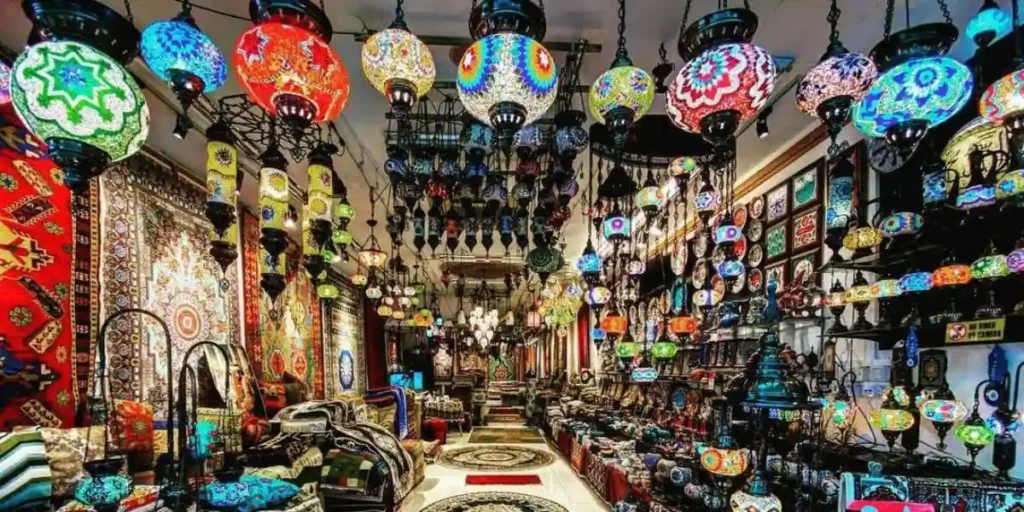Dubai’s Hidden Treasures: 11 Artisan Crafts That Transform Your Shopping Experience
Beyond the Malls: Discovering Dubai’s Authentic Soul
Dubai is celebrated worldwide for its futuristic skyline and extravagant malls, yet beyond the gleaming glass towers lies a different kind of treasure one woven into tradition, artistry, and heritage. If you’re ready to step off the beaten path, Dubai invites you to explore a world where every craft tells a story and every piece carries the soul of the Emirates. Picture yourself returning home not with a mass-produced souvenir, but with an object crafted by hand an intricately woven textile, a delicately carved wooden box, or a piece of jewelry shaped by centuries-old techniques. These are more than purchases; they’re cultural keepsakes infused with meaning. In this guide, we’ll take you through the bustling souks, artisan workshops, and hidden corners of Dubai where authentic crafts come alive. You’ll discover how to spot genuine artistry, learn the stories behind each craft, and experience shopping as an intimate journey into Dubai’s heritage.
By the time you finish this guide, you’ll have the tools to shop confidently and meaningfully. You’ll know how to distinguish authentic handmade crafts from imitations, where to find them, and how to engage with artisans in ways that honor their work. Most importantly, you’ll transform your shopping into a cultural experience supporting local craftsmanship, avoiding tourist pitfalls, and carrying home a piece of Dubai’s spirit that lasts far beyond your trip.
The Allure of Dubai’s Craft Scene
Dubai is often celebrated for its shimmering skyscrapers and luxurious malls, yet its true cultural heartbeat pulses within its craft scene. At this crossroads of ancient Bedouin traditions and bold modern innovation, artisans continue to weave stories into every piece they create. Beyond the polished storefronts, you’ll find souks and workshops where handmade treasures each rich with heritage and artistry, offer a more meaningful shopping experience.
A Journey Beyond Mass Production
Dubai’s cosmopolitan nature has done more than shape its skyline it has preserved age-old craftsmanship while inspiring contemporary interpretations. Here, traditional Emirati skills like weaving, pottery, and metalwork coexist with modern artistic expressions, resulting in a marketplace where history and innovation meet.
The Story in Every Stitch and Stroke:
Each handcrafted item holds more than aesthetic value; it carries the essence of culture, memory, and personal dedication. Whether it’s a rug woven with ancestral patterns, a calligraphy piece infused with spiritual meaning, or jewelry shaped by meticulous hands, these crafts become storytellers in their own right.
Escaping the Generic:
While global brands offer the allure of familiarity, Dubai’s craft scene presents something far more distinctive objects that cannot be replicated on factory lines. Choosing these pieces means embracing individuality, supporting artisans, and taking home a memory that is uniquely yours.
What Makes Craft Shopping in Dubai ‘Special’?
Craft shopping in Dubai is not simply about buying it’s about experiencing. Each visit to a souk or artisan market becomes a journey of cultural immersion, personal connection, and discovery. Beyond the glossy storefronts of global brands, Dubai’s craft scene invites you to slow down, engage with tradition, and take home treasures that carry genuine meaning.
The Experiential Difference
Cultural Immersion
Exploring Dubai’s crafts provides a living introduction to the city’s diverse heritage. From Bedouin weaving techniques passed down through generations to the intricate patterns of Islamic calligraphy, every item reflects values, history, and artistry unique to the Emirates. Shopping here is less a commercial exchange and more an educational journey an opportunity to witness heritage come alive through skilled hands.
Supporting Local Artisans
Each purchase directly supports the livelihoods of craftspeople and their families. By choosing a handmade rug, ceramic bowl, or piece of jewelry, you contribute to the preservation of time-honored skills that might otherwise fade in the face of globalization. This isn’t just shopping it’s a conscious act of sustaining culture and empowering local communities.
Unique Storytelling
Behind every crafted item lies a narrative: the artisan who created it, the materials chosen, and the traditions that shaped its design. These stories transform objects into personal keepsakes tokens of your journey that carry cultural resonance and emotional weight. Unlike mass-produced souvenirs, these pieces invite you to connect with the people and history of Dubai.
Finding One-of-a-Kind Items
Handmade means no two pieces are identical. Whether it’s a hand-painted plate, an embroidered textile, or a carved wooden box, you’re guaranteed a unique treasure. For travelers who value individuality, this exclusivity makes craft shopping in Dubai especially rewarding.
The Joy of Discovery
Perhaps the most special part of Dubai’s craft scene is the adventure itself the thrill of wandering through bustling souks, stumbling upon hidden workshops, and uncovering unexpected gems. Each purchase becomes not just an object, but a memory of the journey you took to find it.
Arabic Calligraphy Art
Description & Cultural Significance
Arabic calligraphy is more than just beautiful handwriting it is one of the most revered art forms in Islamic culture. Rooted in the sacred tradition of depicting Quranic verses, prayers, poetry, and proverbs, calligraphy transforms words into visual expressions of spirituality and wisdom. Each stroke reflects precision, balance, and harmony, making the art both a devotional act and an aesthetic masterpiece.
Across history, different styles have emerged Thuluth with its sweeping elegance, Naskh known for clarity, and Kufic with its bold geometric form. Today, calligraphy extends beyond manuscripts into framed artworks, home décor, personalized gifts, and even contemporary design pieces, allowing you to bring a touch of timeless Islamic artistry into modern living spaces.
Product recommendations: framed calligraphy art, personalized name designs, wooden wall plaques, or ceramic plates adorned with calligraphic motifs.
Where to Find
- Alserkal Avenue (Al Quoz): Dubai’s contemporary art hub, where modern calligraphers reinterpret traditional forms.
- Al Fahidi Historical Neighbourhood (Bastakiya): A cultural haven where you’ll find traditional calligraphy works and may even meet artisans at cultural centers.
- Specialized souk shops: Older markets often house calligraphy stalls featuring decorative plaques, prayer pieces, and home décor.
- Workshops & cultural institutes: Some centers host calligraphy demonstrations and short courses, offering travelers a chance to watch masters at work or even try the art themselves.
Tips for Purchasing
- Look for authenticity: Genuine calligraphy pieces often carry the artist’s signature. Don’t hesitate to ask about the calligrapher’s training and background.
- Check material quality: High-quality ink and durable paper or canvas ensure the piece retains its brilliance over time.
- Personalization matters: Many artists offer custom designs such as your name or a favorite verse making for a unique and deeply meaningful keepsake.
Consider presentation: Opt for framed works or items crafted on wood, ceramic, or canvas for easy display at home.
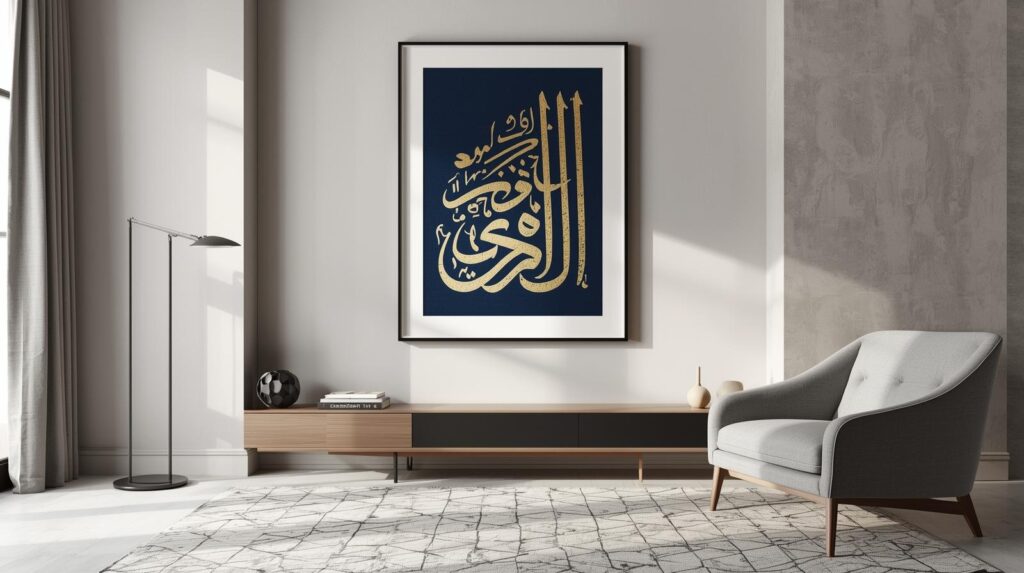
Traditional Textiles (Pashminas, Abayas & Embroidered Fabrics
Textiles have always played an essential role in the cultural identity of the Middle East, serving not only as garments but also as reflections of heritage, artistry, and social status. In Dubai, traditional fabrics range from the luxurious softness of Pashminas, to the understated elegance of Abayas, and the vibrancy of embroidered fabrics that showcase intricate regional craftsmanship.
- Pashminas: Often crafted from fine cashmere, these shawls are prized for their warmth, lightness, and timeless sophistication. While many are imported, their presence in Dubai’s markets has made them a staple gift and fashion accessory.
- Abayas: More than just traditional attire, abayas have evolved into statements of personal style. Embroidery, beadwork, and contemporary cuts add layers of individuality to this classic garment, symbolizing both modesty and cultural pride.
- Embroidered Fabrics: From delicate silk to rich cotton weaves, embroidery patterns often carry symbolic meaning, echoing the artistry passed down through generations. These fabrics are favored for festive wear and bespoke tailoring.
Product recommendations: cashmere Pashminas, designer or custom-embroidered abayas, and silk or cotton fabrics for tailoring unique outfits.
Where to Find
- Textile Souk (Bur Dubai): The city’s most famous destination for traditional fabrics, with rows of shops showcasing pashminas, silk, cotton, and embroidered textiles.
- Deira Boutiques: Specialized shops offering quality abayas and finely woven fabrics, often with opportunities to commission custom designs.
- High-End Fashion Houses: Modern designer abayas that blend tradition with contemporary style can be found in Dubai’s luxury boutiques.
Tips for Purchasing
- Authenticity checks: For pashminas, perform the classic “ring test” a genuine fine pashmina will slip easily through a ring due to its thin, soft weave. Examine the texture for lightness and warmth.
- Inspect embroidery: Flip the fabric and check the reverse side; neat and consistent stitching indicates quality workmanship.
- Fabric feel: Authentic silk and cashmere have a natural softness and subtle sheen that synthetic blends can’t replicate.
- Bargaining etiquette: In souks, polite negotiation is expected and part of the cultural experience don’t hesitate to engage in friendly haggling.
Ask about material composition: Sellers should be transparent about blends (pure cashmere, silk-cotton mixes, etc.) to help you make an informed purchase.
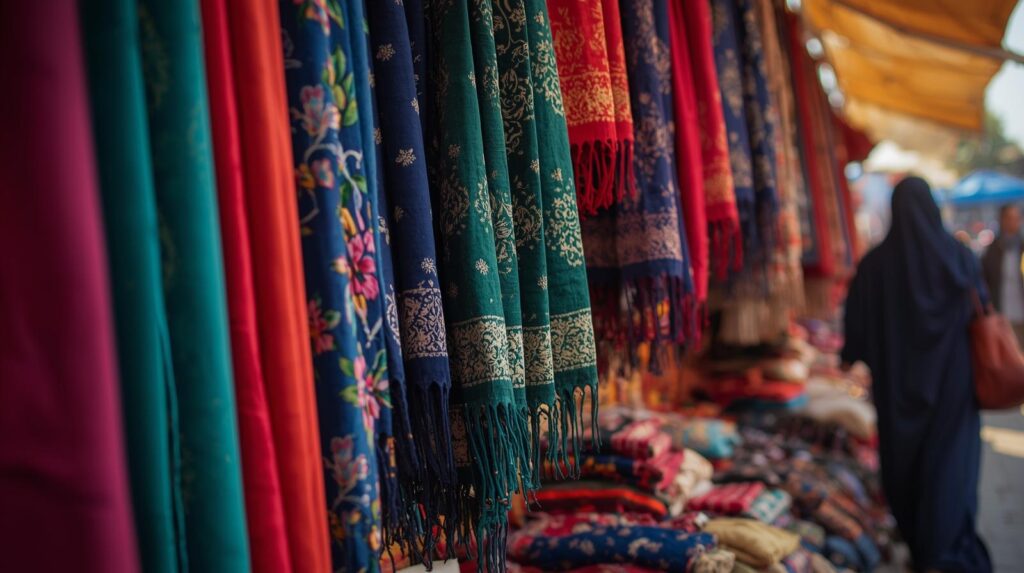
Oud & Bakhoor Products
Few scents are as deeply intertwined with Emirati culture as oud and bakhoor. Known as “liquid gold” in the Middle East, oud is derived from agarwood and treasured for its rich, complex aroma. Distilled into oils, blended into perfumes, or kept as chips, oud carries an aura of luxury and prestige.
Bakhoor, on the other hand, refers to fragrant wood chips or pressed incense bricks, traditionally burned in a mabkhara (incense burner). The perfumed smoke drifts through homes, clothing, and majlis (guest rooms), symbolizing hospitality, warmth, and respect. Whether used to welcome guests, mark religious occasions, or simply enrich daily life, these fragrances are an inseparable part of the region’s identity.
Product recommendations: oud chips, pure oud oil (attar), bakhoor incense bricks, and a traditional mabkhara for burning incense.
Where to Find
- Perfume Souk (Deira): A must-visit destination, where rows of stalls offer a vast selection of oud oils, bakhoor blends, and custom perfumes.
- Specialized Oud Shops: Reputable names such as Ajmal and Arabian Oud are trusted for authentic, high-quality products.
- Department Stores & Malls: Luxury counters often stock curated oud collections and premium bakhoor blends, ideal for those seeking guaranteed authenticity.
Tips for Purchasing
- Understand quality vs. imitation: Pure oud is rare and expensive. Be cautious of products priced suspiciously low, as they are often synthetic blends.
- Sample different grades: High-quality oud has a complex, layered aroma that evolves over time, while cheaper blends may smell flat or overly sweet.
- Test bakhoor with a burn sample: Ask the vendor to light a small piece so you can experience its fragrance as it’s meant to be enjoyed.
- Consider longevity: Pure oud oil can last for hours with just a drop, making it both a luxury and a lasting investment.
- Ask about origins: Oud sourced from regions like Assam (India), Cambodia, and Laos is often prized for its depth and character.
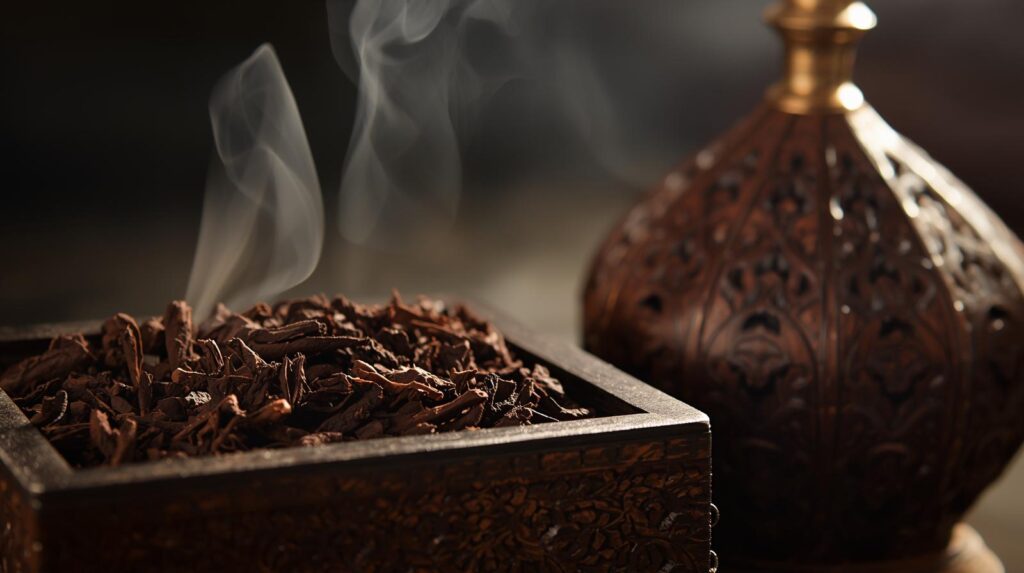
Handmade Pottery & Ceramics
Pottery has long held a place in Emirati life, serving both practical and decorative purposes. Traditionally, clay vessels were used for storing water, cooking, and preserving food in the desert climate. Over time, the craft evolved into an artistic expression, blending geometric patterns, Arabic calligraphy, and desert-inspired motifs that reflect the cultural and natural landscape of the region.
Today, Dubai’s pottery scene embraces both heritage and modern design from rustic earthenware reminiscent of Bedouin life to contemporary ceramics that merge Islamic artistry with sleek, urban aesthetics. These pieces often carry earthy tones of sand and clay, interwoven with vibrant blues, greens, and intricate hand-painted detailing.
Product recommendations: decorative bowls and plates, hand-painted vases, traditional Arabic coffee cups (finjans), and intricate ceramic tiles that echo Islamic mosaic art.
Where to Find
- Al Fahidi Historical Neighbourhood (Bastakiya): Wander its winding lanes to find boutique shops and cultural centers selling handmade pottery infused with tradition.
- Artisan Markets: Events such as the Ripe Market and ARTE, The Makers’ Market regularly feature local ceramic artists showcasing both traditional and contemporary works.
- Specialized Home Décor Boutiques: High-quality decorative ceramics can also be found in Dubai’s curated lifestyle and interior shops.
Tips for Purchasing
- Check craftsmanship: Authentic handmade pottery often bears small imperfections subtle variations that distinguish it from factory-made pieces.
- Glazing and finish: Ensure the glazing is even and the surface has a smooth, durable finish. If buying functional ware (plates, mugs, bowls), confirm the item is food-safe.
- Feel the weight: Well-crafted pottery should feel stable and solid in the hand.
- Fragility & transport: Ask the seller about secure packaging, especially if you’re traveling. Many artisans provide protective wrapping designed for air travel.
Display vs. use: Consider whether you want a decorative item or a practical one, and choose accordingly.
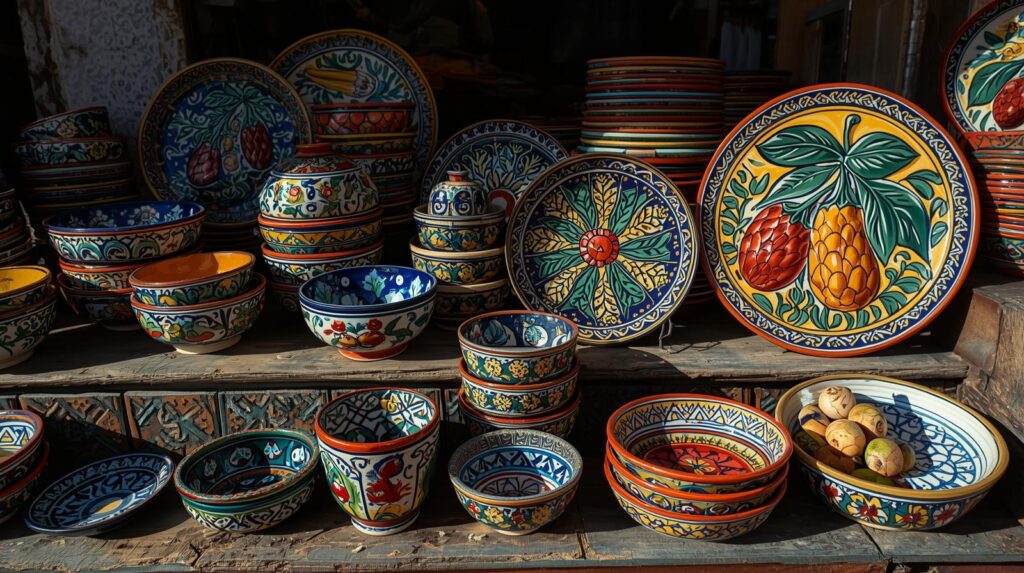
Bedouin Jewelry (Silver & Gemstones)
Among the most striking expressions of Emirati heritage is Bedouin jewelry, traditionally handcrafted in silver and often adorned with semi-precious stones like turquoise, carnelian, and lapis lazuli. For centuries, these pieces were more than adornments they served as portable wealth, protective talismans, and symbols of identity within Bedouin communities.
The motifs tell their own stories:
- Crescents often represent fertility and femininity.
- The Hand of Fatima (Hamsa) is believed to ward off evil.
- Geometric and tribal patterns symbolize strength, resilience, and continuity of tradition.
Each item carries cultural weight, embodying both the practical needs and the spiritual beliefs of the desert-dwelling Bedouin. Today, authentic pieces are prized not only as fashion but as living artifacts of history.
Product recommendations: silver necklaces with turquoise pendants, wide cuff bracelets with intricate filigree, gemstone-embedded rings, and antique earrings that reflect Bedouin craftsmanship.
Where to Find
- Gold Souk (Deira): Beyond its glittering gold displays, certain sections specialize in antique silver jewelry where Bedouin styles can be found.
- Al Fahidi Historical Neighbourhood: Small antique shops here often curate collections of genuine tribal jewelry.
- Specialty Markets & Reputable Dealers: Seek out established vendors who provide provenance and are known for authenticity.
Tips for Purchasing
- Check for sterling silver: Authentic Bedouin jewelry is typically made of 925 sterling silver. Look for hallmarks or ask the seller directly.
- Examine craftsmanship: True handmade pieces showcase intricate filigree, hand-stamped motifs, and natural patinas that develop with age.
- Ask about origin and age: Genuine antique items often come with a story learning the piece’s background enhances its value and ensures authenticity.
- Be wary of replicas: Mass-produced items may mimic the look but lack the weight, detail, and cultural integrity of original Bedouin designs.
- Consider symbolism: Understanding the meaning behind a motif makes the jewelry not just a purchase, but a personal connection to Emirati heritage.
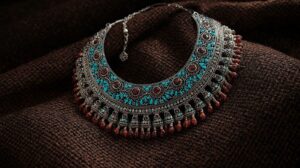
Personalized Sand Art
While many traditional crafts reflect centuries-old practices, personalized sand art represents a more modern expression of Emirati creativity. Inspired by the UAE’s iconic desert landscapes, artists carefully layer colored sand inside glass bottles to form miniature scenes rolling dunes, camels, palm trees, sunsets, and sometimes even falcons.
Its biggest charm lies in personalization. Visitors can request names, dates, or special messages skillfully woven into the artwork, making it a meaningful souvenir to commemorate a trip to Dubai. Beyond being a decorative piece, each bottle captures the spirit of the desert in a portable, vibrant keepsake.
Product recommendations:
- Mini glass bottles with desert and camel scenes
- Larger, intricate designs featuring palm trees and sunsets
- Fully customized bottles with names, quotes, or important dates
Where to Find
- Tourist Souks in Deira & Bur Dubai: Small kiosks and stalls offer quick demonstrations and affordable options.
- Souvenir Shops in Major Malls: Specialized kiosks often feature skilled sand artists creating designs live for customers.
- Traditional Markets & Attraction Shops: Found near cultural attractions where tourists seek unique souvenirs.
Tips for Purchasing
- Look for precision: High-quality sand art has crisp, well-defined lines, not blurry or smudged layers.
- Check colors: Vibrant, evenly layered colors are a sign of skill and care.
- Customize for keepsake value: Add your name, a date, or even a short message to make it a one-of-a-kind memory.
- Ensure sealing & packaging: The bottle should be tightly sealed to prevent shifting, and sturdy packaging is essential for safe transport.
Double-check spellings: When customising, confirm the spelling of names or dates with the artist before sealing.
Mosaic Lamps & Lanterns
Few crafts capture the magic of Arabian Nights quite like mosaic lamps and lanterns. These intricately designed pieces, often influenced by Turkish and Levantine artistry, are made with hand-cut glass arranged into vibrant geometric and floral patterns. When lit, they cast a warm, kaleidoscopic glow that transforms any room into a cozy, atmospheric retreat.
Although their roots trace back to Ottoman and Levantine traditions, these lamps have become a beloved decorative staple in Dubai, admired for their ability to blend artistry with functionality. Beyond simple lighting, they serve as statement pieces symbolizing hospitality, warmth, and timeless design.
Product recommendations:
- Table Lamps – perfect for bedside or living room accents
- Hanging Lanterns – suspended for dramatic, ambient lighting
- Wall Sconces – decorative and functional wall décor
- Multi-lamp Chandeliers – for those wanting a bold centerpiece
Where to Find
- Spice Souk, Deira: A treasure trove for colorful mosaic lamps, often clustered in glowing displays.
- Al Fahidi Historical Neighbourhood: Small artisan shops where you can find authentic, handcrafted designs.
- Specialized Lighting Stores & Markets: Larger collections with varying sizes, patterns, and electrical fittings.
Tips for Purchasing
- Check the craftsmanship: High-quality lamps feature smooth soldering and securely fixed glass pieces. Poor workmanship may lead to loose or uneven mosaics.
- Inspect electrical fittings: Ensure the lamp wiring meets safety standards and confirm the bulb type and wattage recommended.
- Fragility & transport: These lamps can be delicate. Ask vendors about professional packaging or consider hand-carrying smaller items.
- Design consistency: Genuine handmade lamps will have slight variations but should still maintain an overall balanced, cohesive pattern.
Size & décor match: Consider where it will be placed at home colors and patterns look different when illuminated.
Leather Goods (Wallets, Bags, Footwear)
Leatherwork has been part of the region’s heritage for centuries, once essential for saddles, pouches, and durable footwear that supported life in the desert. Today, this tradition lives on through handcrafted leather goods that balance practicality with style.
One of the most distinctive materials is camel leather, valued for its strength, flexibility, and unique textured grain. It stands out from conventional cowhide and reflects a piece of the Arabian identity. Whether in the form of finely stitched wallets, elegant handbags, sturdy belts, or traditional Arabic sandals (na‘al), these items combine durability with artistry.
Product recommendations:
- Handmade Wallets & Handbags – combining modern functionality with traditional patterns
- Belts – crafted from camel or cow leather, often with decorative embossing
- Arabic Sandals (Na‘al) – classic regional footwear still popular today
- Custom-designed pieces – from embossed initials to entirely bespoke items
Where to Find
- Old Souk (Bur Dubai & Deira): A hub for traditional leather artisans offering both ready-made and custom designs.
- Al Fahidi Historical Neighbourhood: Boutique stores specializing in authentic leather craftsmanship.
- Artisan Markets & Craft Fairs: Occasional stalls featuring smaller makers with unique, modern interpretations.
Tips for Purchasing
- Check authenticity: Genuine leather has a distinct earthy smell and natural texture. Avoid overly shiny or plasticky finishes that may indicate synthetic material.
- Examine craftsmanship: Look for clean, even stitching and sturdy seams that ensure durability.
- Ask about the leather type: Camel leather offers local authenticity and excellent resilience, while cowhide may be softer and more flexible.
- Customization options: Many artisans can emboss initials, create bespoke fittings, or design custom sizes for a personal touch.
Care considerations: Keep leather goods conditioned with a quality leather cream and store them away from excess heat or humidity to preserve suppleness.
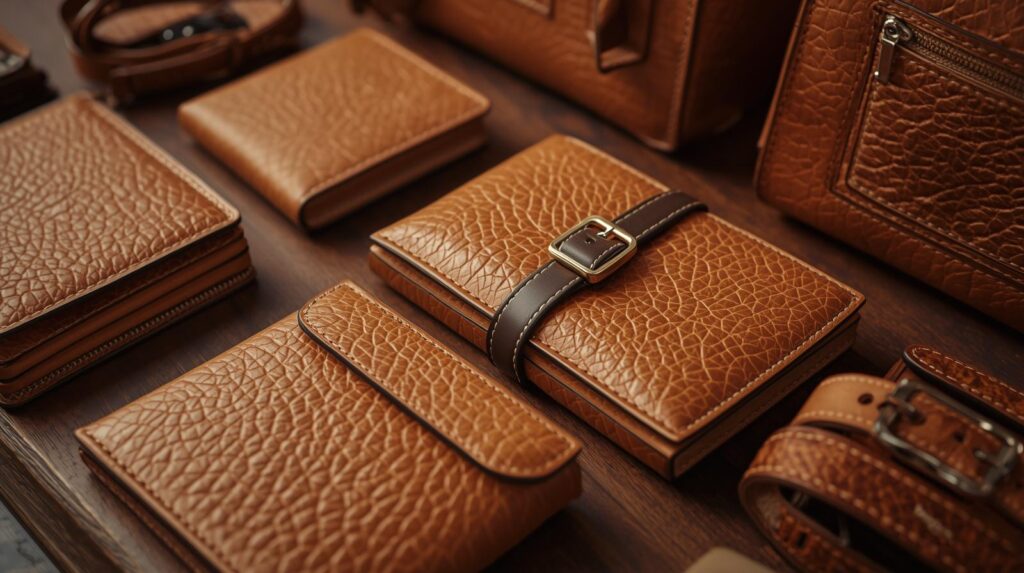
Date Palm Weaving (Sadu/Al Khous)
Few materials are as central to Emirati heritage as the date palm. Known as the “tree of life,” it provided food, shelter, and essential raw material for daily living. From its dried fronds, Bedouins developed Al Khous weaving, a craft that transformed humble leaves into baskets, mats, fans, and food covers objects vital for desert survival.
Parallel to this is Al Sadu weaving, a UNESCO-recognized intangible cultural heritage. Traditionally practiced by Bedouin women, Sadu involves hand-weaving geometric patterns from wool, often in striking red, black, and white. These textiles were used in tents, camel saddles, and decorative elements that carried both practical and cultural symbolism.
Together, these crafts reflect resourcefulness, artistry, and a deep connection to nature a tradition that continues today as both functional and decorative art.
Product recommendations:
- Date Palm (Al Khous): baskets, mats, food covers, fans, wall hangings
- Sadu Weaving: carpets, cushion covers, saddle bags, decorative throws
Where to Find
- Heritage Village (Abu Dhabi): Demonstrations and authentic woven items by skilled artisans.
- Al Fahidi Historical Neighbourhood (Dubai): Craft shops and cultural centers showcasing both Al Khous and Sadu.
- Artisan Markets & Cultural Festivals: Seasonal stalls where women weavers sell directly, often explaining their techniques.
Tips for Purchasing
- Assess weave quality: Look for tight, even weaving and strong construction. Loose or uneven patterns may fray over time.
- Ask about materials: Ensure palm fronds or wool are naturally dyed and colorfast.
- Learn the story: Authentic pieces often come with the artisan’s background or cultural context adding to their value.
- Consider functionality vs. decor: Some items are meant for daily use, while others are purely decorative. Choose accordingly.
Henna Art (as a Craft & Experience)
Henna, derived from the leaves of the Lawsonia inermis plant, has been used for centuries across the Middle East, South Asia, and North Africa as a form of temporary body art. In Emirati culture, it is deeply tied to celebrations, weddings, and festivals like Eid. The intricate designs are not only decorative but often symbolize beauty, joy, blessings, and good fortune.
Applied most commonly to the hands and feet, henna art is a living tradition one that blends the artistry of the past with contemporary creativity. While many visitors experience henna as a cultural souvenir, it also represents a craft passed down through generations, where each swirl, floral motif, or geometric line carries both aesthetic and cultural meaning.
Product recommendations
- Experience: Have your hands or feet adorned with fresh henna by a skilled local artist.
- Take-home option: Purchase natural henna paste cones or DIY kits to try your hand at this art form at home.
Where to Find
- Henna Salons: Found throughout Dubai, offering traditional and modern styles.
- Souks & Tourist Markets: Stalls in places like Global Village or traditional souks often have henna artists available for quick, authentic applications.
- Cultural Heritage Spots: In Al Fahidi Historical Neighbourhood and during festivals, henna demonstrations are offered as part of cultural experiences.
Tips for Purchasing or Experiencing Henna
- Choose natural henna: Look for reddish-brown paste only. Avoid “black henna,” which may contain PPD (paraphenylenediamine) a chemical that can cause severe allergic reactions.
- Check hygiene standards: Ensure the artist uses fresh paste, clean applicators, and sanitary practices.
- Ask about design options: Traditional Emirati patterns are often floral and geometric, while modern styles may incorporate glitter or fusion influences.
DIY kits: If buying cones or kits, check expiry dates and confirm the paste is 100% natural.
- Experience: Have your hands or feet adorned with fresh henna by a skilled local artist.
Bespoke Perfumes (Attar)
In the Arabian world, fragrance is far more than a finishing touch it is a deeply personal expression of identity, heritage, and hospitality. For centuries, attar (alcohol-free, oil-based perfumes made from natural ingredients) has been prized across the Middle East for its purity and longevity. Unlike mass-produced perfumes, attar is hand-blended by master perfumers, often using luxurious ingredients like oud, musk, amber, rose, jasmine, and saffron.
Attar is also deeply symbolic. It is often gifted during weddings, celebrations, and religious occasions, symbolizing respect, generosity, and refinement. What makes the craft of bespoke attar especially alluring is the ability to create a signature scent, tailored to reflect your personality and preferences a sensory keepsake of Dubai that goes beyond the ordinary.
Product recommendations:
- Custom-blended attar oils tailored by skilled perfumers.
- Traditional oud-based perfumes (oud is considered the “liquid gold” of Arabian perfumery).
- Exotic single-note oils, such as rose, amber, or sandalwood.
Where to Find
- Perfume Souk in Deira: The heart of Dubai’s fragrance culture, where small family-run shops allow visitors to explore and experiment with blends.
- Specialized Attar Shops: Scattered across the city, often run by generations of perfumers who uphold traditional methods.
- High-End Fragrance Boutiques: Luxury outlets that merge Arabian traditions with modern perfume artistry.
Tips for Purchasing Bespoke Perfumes
- Take your time: Sampling too many fragrances too quickly can overwhelm your sense of smell. Pause between scents, and revisit your favorites before deciding.
- Explore the layers: Familiarize yourself with base notes (oud, musk, amber) and top notes (rose, jasmine, saffron). This helps you appreciate how the scent evolves on your skin.
- Opt for customization: Work with a perfumer to craft a unique blend that resonates with your identity this is what makes attar shopping in Dubai truly special.
Check authenticity: Ensure the oils are natural and not overly diluted with synthetics. Trust reputable, long-established shops.
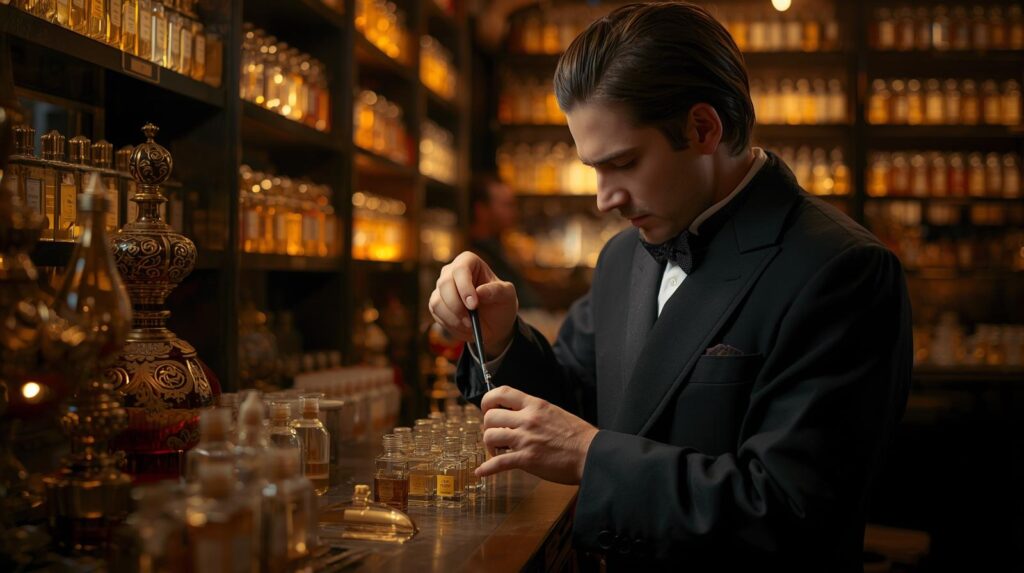
Mastering the Souk: Essential Tips for an Unforgettable Craft Shopping Journey
Navigating Dubai’s bustling souks and artisan markets can feel like stepping into a living museum vibrant colors, exotic scents, and an endless array of handmade treasures. But to make your shopping adventure both smooth and rewarding, it helps to know the unspoken rules and insider tips. Here’s your essential guide to making the most of your craft shopping journey.
1. The Art of Bargaining: Respectful Negotiation
In Dubai’s traditional souks, bargaining isn’t just allowed it’s expected. Think of it as a cultural ritual rather than a stressful tug-of-war.
- Expert Tip: Begin your counter-offer at 30–50% lower than the asking price. Sellers usually quote high, anticipating negotiation.
- Strategy: Stay polite, keep a friendly smile, and don’t be afraid to walk away. More often than not, the vendor will call you back with a better deal.
- Why It Matters: This approach ensures you pay a fair price while respecting the cultural tradition of negotiation.
Helps visitors avoid overpaying or feeling tricked in touristy spots.
2. Spotting Authenticity: Your Guide to Genuine Crafts
Handcrafted items have a soul slight imperfections, unique textures, and a story behind them. Mass-produced souvenirs, on the other hand, lack character.
- Expert Tip: Look for natural imperfections they’re usually signs of authenticity.
- Ask Questions: Genuine artisans proudly explain the materials, techniques, or cultural meaning of their craft.
- Certificates of Authenticity: For premium purchases like carpets, artworks, or fine jewelry, ask for documentation from reputable sellers.
Audience Pain Point Solved: Prevents buyers from mistaking factory-made goods for artisanal treasures.
3. Where to Shop: Traditional Souks vs. Modern Artisan Markets
Dubai offers the best of both worlds: centuries-old souks and modern artisan markets.
- Traditional Souks to Explore:
- Gold Souk, Spice Souk, Textile Souk, and Perfume Souk in Old Dubai’s Deira district iconic, immersive, and steeped in history.
- Gold Souk, Spice Souk, Textile Souk, and Perfume Souk in Old Dubai’s Deira district iconic, immersive, and steeped in history.
- Modern Artisan Markets:
- Ripe Market, ARTE (Artisans of the Emirates), and The Makers Market perfect for connecting directly with contemporary local creators.
- Ripe Market, ARTE (Artisans of the Emirates), and The Makers Market perfect for connecting directly with contemporary local creators.
Clears up the confusion of where to find authentic, artisan products.
4. Cultural Etiquette: Shopping with Respect
Respecting local customs enhances the shopping experience and builds goodwill with vendors.
- Dress Modestly: Especially in traditional souks.
- Greetings Matter: A polite “Salam Alaikum” (peace be upon you) can warm up a conversation instantly.
- Photography Courtesy: Always ask before snapping pictures of people or their stalls.
- Understand Before You Buy: Knowing the cultural symbolism of an item (like henna, calligraphy, or oud) deepens its value and meaning.
- Ensures visitors feel comfortable navigating cultural norms.
5. Practical Logistics: Payments, Shipping, and Timing
Planning ahead saves both stress and money.
- Cash vs. Card: While malls and big shops take cards, most souk vendors prefer cash. Carry small denominations.
- Shipping & Customs: For bulky or fragile crafts, ask about shipping services. Check your country’s import rules for items like perfumes, antiques, or animal-based products.
- Best Times to Shop:
- Cooler months (October–April): More pleasant for outdoor markets.
- Evenings: Souks come alive with atmosphere.
- Early mornings: Ideal for a quieter browsing experience.
- Cooler months (October–April): More pleasant for outdoor markets.
Tackles practical worries about payment, transport, and avoiding peak crowds. Shopping in Dubai’s souks is more than a retail experience it’s a cultural journey. By mastering the art of respectful bargaining, spotting authenticity, and observing local etiquette, you’ll not only bring home meaningful treasures but also lasting memories of your time in the city.
Conclusion: Taking a Piece of Dubai’s Soul Home
Exploring Dubai’s artisan crafts isn’t just about filling a shopping bag it’s about carrying home a story. Each handwoven textile, carved trinket, or bespoke attar bottle is a living testament to centuries of craftsmanship, tradition, and creativity. When you choose authentic, handmade pieces, you’re not only supporting local artisans but also preserving a cultural heritage that thrives in the heart of Dubai’s souks and markets.
These treasures are more than souvenirs; they are lasting keepsakes infused with meaning reminders of warm exchanges with shopkeepers, the hum of the bazaar, and the scent of spices in the air. Whether you’re a traveler seeking a unique memento or a resident deepening your connection to the city, artisan crafts offer a way to weave Dubai’s spirit into your own story.
So wander the markets with curiosity, take the time to learn from the makers, and let the beauty of Dubai’s soul come home with you piece by piece, craft by craft.
